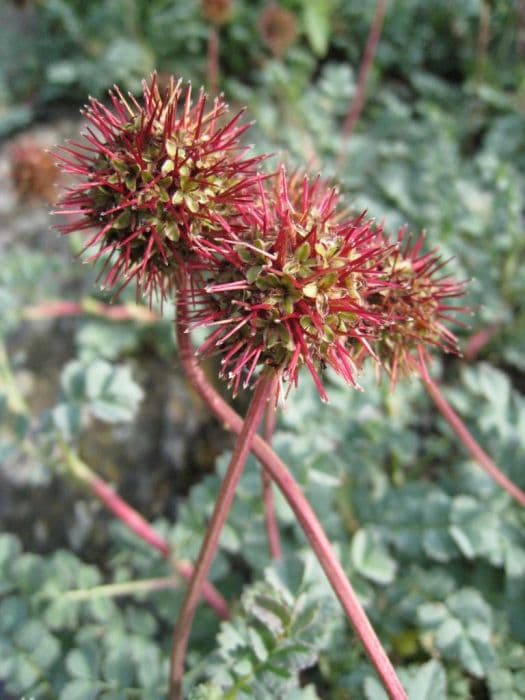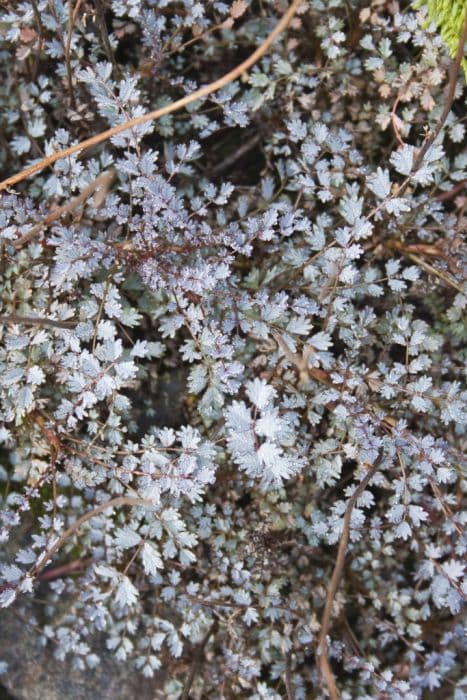James Grieve Apple Malus domestica 'James Grieve' (D)

ABOUT
The Apple 'James Grieve' is a widely cultivated fruit tree known for its attractive appearance and flavorful fruit. The tree is adorned with an appealing canopy of green leaves that provide a lovely backdrop for its spring blossoms. In springtime, it bursts into life with a profusion of flowers. The blooms are typically pink-tinged at bud stage, opening to a beautiful display of blush white petals that are not only picturesque but also a source of early nectar for pollinators. As the seasons progress, the true glory of the 'James Grieve' apple becomes apparent with the development of its fruit. The apples themselves usually exhibit a vibrant mix of colors, often featuring a yellow-green base overlaid with patches or stripes of red, giving them an appetizing appearance. The skin of the fruit is smooth with a slight sheen, and its size is generally medium, comfortable to hold and eat out of hand. The flesh of the 'James Grieve' apple is typically juicy and tender, with an excellent balance of sweetness and acidity, making it very enjoyable to eat fresh. It is also versatile, often used in cooking and baking due to its flavor and texture.
About this plant
 Names
NamesFamily
Rosaceae
Synonyms
James Grieve Apple
Common names
Malus domestica 'James Grieve'.
 Toxicity
ToxicityTo humans
The plant commonly known as apple, specifically the 'James Grieve' variety, is not considered toxic to humans when its fruit is consumed as food. However, the seeds inside the apple contain amygdalin, which can release cyanide when digested. Ingesting a small number of apple seeds is unlikely to cause harm due to the low quantity of amygdalin they contain, but consuming them in large quantities could potentially lead to cyanide poisoning. Symptoms of cyanide poisoning include headache, confusion, dizziness, shortness of breath, and seizures. In extreme cases, it can lead to respiratory failure and death. It is important to note that the seeds would need to be chewed or crushed to release the amygdalin; intact seeds passing through the digestive system do not pose the same risk.
To pets
Apple, including the 'James Grieve' cultivar, is not poisonous to pets when the flesh of the fruit is eaten in moderation. However, similar to humans, the seeds contain amygdalin, which can be harmful if ingested in large amounts. If a pet chews and swallows a considerable number of apple seeds, there is a risk of cyanide poisoning. Symptoms may include dilated pupils, difficulty breathing, panting, shock, and in severe cases, coma or death. Pets should not be given large quantities of apples at one time, and the seeds and core should be removed before sharing any pieces of the fruit with them to prevent the risk of cyanide exposure.
 Characteristics
CharacteristicsLife cycle
Perennials
Foliage type
Deciduous
Color of leaves
Green
Flower color
White
Height
12-16 feet (3.6-4.8 meters)
Spread
12-15 feet (3.6-4.5 meters)
Plant type
Tree
Hardiness zones
4-8
Native area
Asia
Benefits
 General Benefits
General Benefits- Edible Fruit: The apple can be eaten fresh, cooked, or used in various recipes.
- Ornamental Value: This variety has aesthetic appeal with its blossoms and fruit.
- Shade Provider: Mature trees can offer shade for smaller plants or garden areas.
- Pollinator Attraction: Blossoms attract bees and other pollinating insects.
- Environmental Impact: Trees help in reducing carbon footprint by absorbing carbon dioxide.
- Soil Improvement: The root system can help in preventing soil erosion and improving soil health.
- Crafting and Cooking: Apples are used in crafts and cooking, such as making cider or apple pies.
- Habitat: Trees can provide habitat and food for wildlife, such as birds and squirrels.
 Medical Properties
Medical Properties- This plant is not used for medical purposes.
 Air-purifying Qualities
Air-purifying QualitiesThis plant is not specifically known for air purifying qualities.
 Other Uses
Other Uses- As a natural dye: The skin of apples, including the James Grieve variety, can be used to create a natural dye for fabrics or crafts, providing a range of colors from yellow to brown depending on the mordant used.
- In woodcrafting: Apple wood is known for its fine grain and durability, making it suitable for small woodworking projects such as carving, turning, or making small furniture pieces.
- As a smoking wood: Apple wood chips from the James Grieve apple tree are used in smoking meats to infuse a sweet, fruity flavor that complements pork and poultry particularly well.
- In natural pest control: Apple wood can sometimes repel certain insects, and branches or chips might be used in gardens to deter pests naturally.
- As a plaything for pets: Twigs from the apple tree can be given to rabbits or other rodents to chew on, which helps keep their teeth healthy and provides enrichment.
- For educational purposes: This particular apple variety can be used in schools or educational programs to teach students about plant genetics, hybridization, and fruit cultivation techniques.
- In art projects: Dried apple slices from the James Grieve apple can be incorporated into craft projects or used as natural decorations in floral arrangements or wreaths.
- As a stamping tool: A halved James Grieve apple can be used with paint or ink to create stamped patterns, making it a fun art tool for children.
- In culinary experimentation: The James Grieve apple's flavor profile and acidity levels can be explored in molecular gastronomy to create apple-infused foams, emulsions, or gels for avant-garde dishes.
- As compost material: Fallen leaves and decomposing apples from the James Grieve tree can be added to compost bins where they decompose and enrich the soil with nutrients.
Interesting Facts
 Feng Shui
Feng ShuiThe apple tree is not specifically used in Feng Shui practice.
 Plant Symbolism
Plant Symbolism- Love and Temptation: The apple, from which the James Grieve variety comes, has often symbolized love and temptation, dating back to the story of Adam and Eve in the biblical tale where the apple represents the forbidden fruit.
- Knowledge and Wisdom: In Western traditions, apples are linked to knowledge and wisdom, as depicted in various mythologies and folklore where apples grant wisdom or reveal truths.
- Youth and Beauty: Mythology often presents the apple as a symbol for youth and beauty, as in the tale of the golden apples in the Garden of the Hesperides which granted eternal youth.
- Fertility and Abundance: The apple’s plentiful harvest and the fruit's role in agricultural societies have linked it to symbols of fertility and abundance.
- Peace and Harmony: Presenting an apple or apple tree is sometimes seen as an offer of peace, possibly because the blossoming tree represents harmony with nature.
 Water
WaterThe common James Grieve apple tree should be watered deeply and thoroughly to encourage root development, typically receiving about 1 to 2 gallons of water per week, depending on the weather and soil moisture levels. During the growing season, especially in the absence of rainfall, more frequent watering may be necessary, possibly twice a week. Soil should be allowed to dry out slightly between waterings to prevent root rot. Young trees in their first growing season will require more consistent watering to establish their root systems. Decrease watering frequency as the tree matures and monitor soil moisture to adjust as needed.
 Light
LightJames Grieve apple trees require full sun, with at least six hours of direct sunlight daily to produce the best fruit. Plant the tree in a location where it is not overshadowed by taller plants or buildings. The tree will thrive in a spot that gets unobstructed sunlight from morning to afternoon.
 Temperature
TemperatureThe James Grieve apple tree prefers temperate conditions and usually fares well in a wide range of temperatures, ideally thriving at 60 to 75 degrees Fahrenheit. It can withstand winter lows down to about -20 degrees Fahrenheit but should be protected from frost during its flowering period in the spring. The tree's blossoms and fruit can be damaged by late spring freezes.
 Pruning
PruningPrune James Grieve apple trees annually to maintain their health and shape, usually during the dormant season in late winter before spring growth starts. Remove any dead, damaged, or diseased limbs, and thin out crowded branches to allow sunlight and air circulation. Pruning also stimulates the growth of fruiting spurs and should be done carefully to balance fruit production and the tree's energy.
 Cleaning
CleaningAs needed
 Soil
SoilThe apple 'James Grieve' thrives in well-draining loamy soil with a pH between 6.0 and 7.0. To create the best soil mix, combine garden soil, compost, and peat moss in equal parts. This will provide adequate nutrients and proper drainage for the apple tree's root system.
 Repotting
RepottingApple trees like 'James Grieve' typically do not require frequent repotting as they are usually planted directly in the ground. However, if grown in containers, young trees may be repotted every 2-3 years to provide sufficient space for root growth until they are planted out permanently.
 Humidity & Misting
Humidity & MistingThe apple 'James Grieve' is tolerant of a wide range of humidity levels, typical of outdoor environments. It does best in moderate humidity but can handle the natural fluctuations found in most temperate climates where apples are commonly grown.
 Suitable locations
Suitable locationsIndoor
Growing 'James Grieve' apple trees indoors is not recommended due to their size.
Outdoor
Plant in full sun, space trees 15-20 ft apart, and provide regular watering.
Hardiness zone
4-8 USDA
 Life cycle
Life cycleJames Grieve apple trees, like other Malus domestica varieties, begin their life cycle as seeds that germinate in suitable conditions of soil, temperature, and moisture. Upon sprouting, the seedling grows into a young tree through a period of vegetative growth, developing roots, stems, and leaves. As the tree matures, it enters a phase of reproductive growth, typically by the age of 4 to 6 years, when it begins to produce flower buds. In spring, the buds blossom into flowers that can be pollinated by insects, resulting in the formation of fruit. The apples reach maturity and are ready for harvest in late summer to early autumn. After fruiting, the tree enters a dormant period during winter to conserve energy, completing its annual cycle, and as a perennial plant, this cycle repeats for many years.
 Propogation
PropogationPropogation time
Late winter - early spring
The apple variety known as 'James Grieve' is typically propagated through a method called grafting, particularly during the dormant season which is late winter to early spring. Grafting involves taking a scion, which is a piece of the stem with buds, from a 'James Grieve' apple tree and attaching it to a rootstock, which is a young tree or root that will support the grafted scion. The scion should be about 6 to 8 inches (15 to 20 centimeters) long, with at least two to three buds. The rootstock determines the size of the tree, and dwarfing rootstocks are often used for 'James Grieve' to produce smaller trees that are easier to harvest. The cut surfaces of scion and rootstock are matched up and fixed tightly together using grafting tape or a similar material, ensuring that the cambium layers of both the scion and the rootstock are in contact. This union of the scion and rootstock must then be kept moist and allowed to heal, which usually takes several weeks. Once the graft has taken and growth resumes, the new tree will bear the fruit characteristics of 'James Grieve.'









